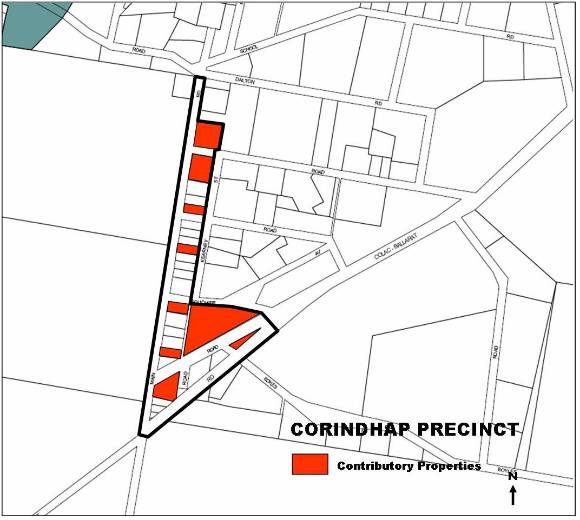| Back to search results » | Back to search page » |
|
Corindhap Precinct
LocationColac-Ballarat Rd Corindhap, Golden Plains Shire LevelIncluded in Heritage Overlay |
|
Statement of Significance
What is Significant? The township of Corindhap, formerly known as Break-O-Day, is located approximately 5 kms north east of Rokewood and 45 kms south of Ballarat on the Colac-Ballarat Road. The Corindhap area was originally occupied by the Derwent Company as the Wardie Yallock run (later to be known as Kurruck Kurruck), then held by a partnership which included the Atchison brothers in 1839. John Elder, who was a brother-in-law to the Atchisons, held the lease to the Mindi run between 1850 and 1857. Elder purchased the Kurruck Kurruck run in 1857, with his sons taking control of the property in 1863 and renaming it Kuruc-a-ruc in 1864. Gold was first discovered on Boundary Hill in 1852. The Break of Day Gully (Corindhap) goldfield opened in April-September 1856 with the big rush taking place there in 1861, which resulted in the population of the area reaching 5,000 at its peak. The mining was alluvial. Quartz mining was tried but was unsuccessful. Some of the existing miners' cottages could date from this period. The Break-O'Day Hotel, which survives today, was built in 1869. It is a single storey masonry building located at the main intersection of the town. The first school was established by the miners in the 1860s. Corindhap was officially proclaimed a town in 1874 and the substantial infrastructure of gutters, drains and culverts probably dates from this period. St John's Anglican Church was built in the early twentieth century and the copse of significant Pinus pinea (Stone Pines) probably dates from the same time. The Presbyterian Church has been removed to Rokewood Junction. By 1914, Corindhap was described in municipal directories as a mining and agricultural district with a State School, Church, Mechanics' Institute and Library, and Oddfellows' Hall. Its population had fallen to 300 but, with the decline of mining and relatively little employment from pastoralism and agriculture, it declined further to a stable 250 through most of the twentieth century. Only one commercial building, the former combined post office and butcher's shop, with its associated dwelling, survives from the early twentieth century. The First World War Avenues of Honour, consisting of traditional Cupressus macrocarpa (Monterey Cypress) and Pinus radiata (Monterey or Radiata Pine) were planted along in the Ballarat-Colac Road. The avenue was opened on 15 September 1917 by Cr James Boyle. Some of the latter trees situated within the Avenue, the minor deviation of the Colac-Ballarat Road, have been carved into sculptures. Perhaps the last substantial building to be erected in the township was the new Memorial Hall in 1956, replacing the Mechanics Institute. The township remains sparsely developed with many of the cottages in poor condition. How is it Significant? The township of Corindhap is of historical, architectural and social significance to the Golden Plains Shire.
Why is it Significant? The township of Corindhap is of historical significance as one of the many small settlements in the Shire established on the site of gold rushes in the 1850s and 1860s, several of which have survived into the twenty-first century. It is of architectural significance for its range of very modest buildings dating from the nineteenth century, an example being the Break O'Day Hotel. The buildings are complimented by substantial avenues of honour and other mature trees, as well as the surviving infrastructure. The township is of social significance for its survival from a peak of several thousand, reflected in some surviving public buildings and cottages, to its modern population of less than one hundred. The township reflects the inter-relationship between pastoral, mining and agricultural pursuits.
Group
Education
Category
School - State (public)




